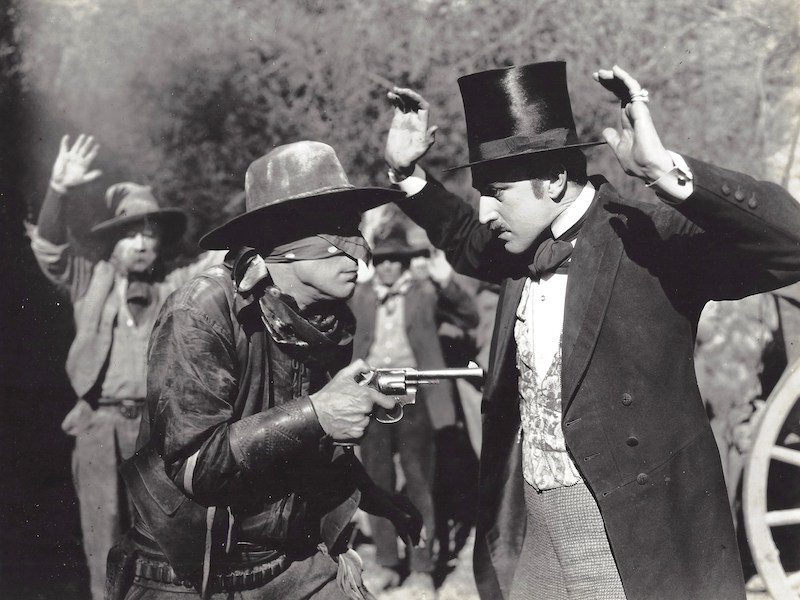THE SILENT MAN
William S. Hart (US 1917)
The Silent Man (the second of Hart’s Artcraft features produced, but the first to be released) was welcomed by fans after a long summer without a new film from their favorite cowboy star. Hart had finished work for Triangle in May 1917, then waited for the smoke to clear as Ince’s Triangle connections dissolved in acrimony. The producer was hustling to secure a new base for the distribution and financing of his product, using his presumed personal bond with Bill Hart, box office gold, as a strong bargaining chip. In spite of lucrative offers from Goldwyn, Zukor, and others for an independent deal, Hart supported Ince’s campaign and by July 26 they settled together on a generous contract with Famous Players-Lasky. “Supervision by Thomas H. Ince” was specified, maintaining the producer’s prestige. Ince also received an equal partnership in William S. Hart Productions, splitting 35% of the profits, and was paid over $250,000 per year as producer for that unit.
Charles Kenyon, a freelancer who had written for Biograph, Fox, Universal, and Ince since 1915, built up a short J. G. Hawks storyline into a plot chock-full of popular Hart incident, though his scenario lacks the central narrative drive so prized in the Ince brand. Nonetheless, there are many rewarding new characterizations, such as a very jovial “Silent” Budd Marr, really enjoying his long drink of water at the Hello Thar dance hall, and his “abduction” of Betty Bryce (played with spirit by winsome Vola Vale, another Biograph alum), managed with charming comedy and due respect for all the proprieties. Marr shows a fury towards capitalist claim jumpers that may well have reflected Hart’s growing sense of grievance regarding his own work. He is creating “gold” for movie moguls with his labor and skill, that gold now being siphoned off through legal and financial finagling. Triangle had quickly begun flooding the market with dozens of retitled versions of his old pictures, damaging the Hart brand and forcing his new films to compete with these low-cost reissues.
The Silent Man is a portrait, not of the Good Badman, but of a “’bad” Badman, an inconsistent and repentant Badman. He is scarcely the ruthless Nietzschean superman posited by the opening titles. Rather, we meet a hardworking, humorous, even religious prospector, “a helping sort of hombre.” His expertise in the desert does not prepare him for the human snakes met in Bakeoven. Though he is a savvy fellow, their perfidy operates at a scale he cannot imagine.
Hart’s films often referenced evangelical Protestant values, as embodied in the characteristic figure of an itinerant preacher, sometimes criticized, sometimes valorized. “Silent” Budd Marr is close friends with “Preachin’ Bill” Hardy, an estimable populist pastor, acted by Griffith regular George Nichols as an earthy, compassionate, and devout figure. (This positive portrayal leads the strict Methodist minister played by Fredric March in the 1941 film One Foot in Heaven to change his mind about the sinfulness of this new medium after he sees The Silent Man at a local nickelodeon.) Marr sees his old friend’s church and cabin burnt by Pressley’s desperados, and he himself almost kills his sweetheart’s little brother with a hasty shot. He is appalled by the destruction his vigilante quest for justice has generated and chooses Christian surrender rather than continued violence to end the catastrophe. He allows himself to be captured, a man of sorrows, to deliver reward money to Hardy and little Davie Bryce in compensation for their suffering. Fortunately for the fans, Marr is also capable of diving from a second-story window, lassoing the villain and dragging him in the dust to justice!
Was production rushed to fill the exhibition gap left by the delay of The Narrow Trail? Editing of the dramatic showdown at the dance hall card game is rather jumbled and the courtroom finale suffers from clumsy blocking. Some small but useful expository scenes referenced in the press book synopsis are missing in this print (Pressley bribing a government agent to change Marr’s claim details; a threat to Betty’s reputation if Marr explains himself in court). Hart’s preference for separation from Ince had a downside, because these are rough edges the producer would not have tolerated, and this tension would color Hart’s work through the rest of his Artcraft contract.
Diane Koszarski


regia/dir: William S. Hart.
sogg/story, scen: Charles Kenyon.
photog: Joe August.
asst dir: Lambert Hillyer.
cast: William S. Hart (“Silent” Budd Marr), Vola Vale (Betty Bryce), Robert McKim (“Handsome Jack” Pressley), Harold Goodwin (David Bryce), J. P. Lockney (“Grubstake” Higgins), George P. Nichols (“Preachin’ Bill” Hardy), Gertrude Claire (Mrs. Hardy), Milton Ross (Ames Mitchell), Dorcas Matthews (Topaz).
prod: William S. Hart Productions, supv: Thomas H. Ince.
dist: Paramount-Artcraft.
uscita/rel: 26.11.1917.
copia/copy: DCP, 56’41”; did./titles: ENG.
fonte/source: Library of Congress Packard Center for Audio-Visual Conservation, Culpeper, VA.
Preserved by the Library of Congress in cooperation with the Academy Film Archive.




